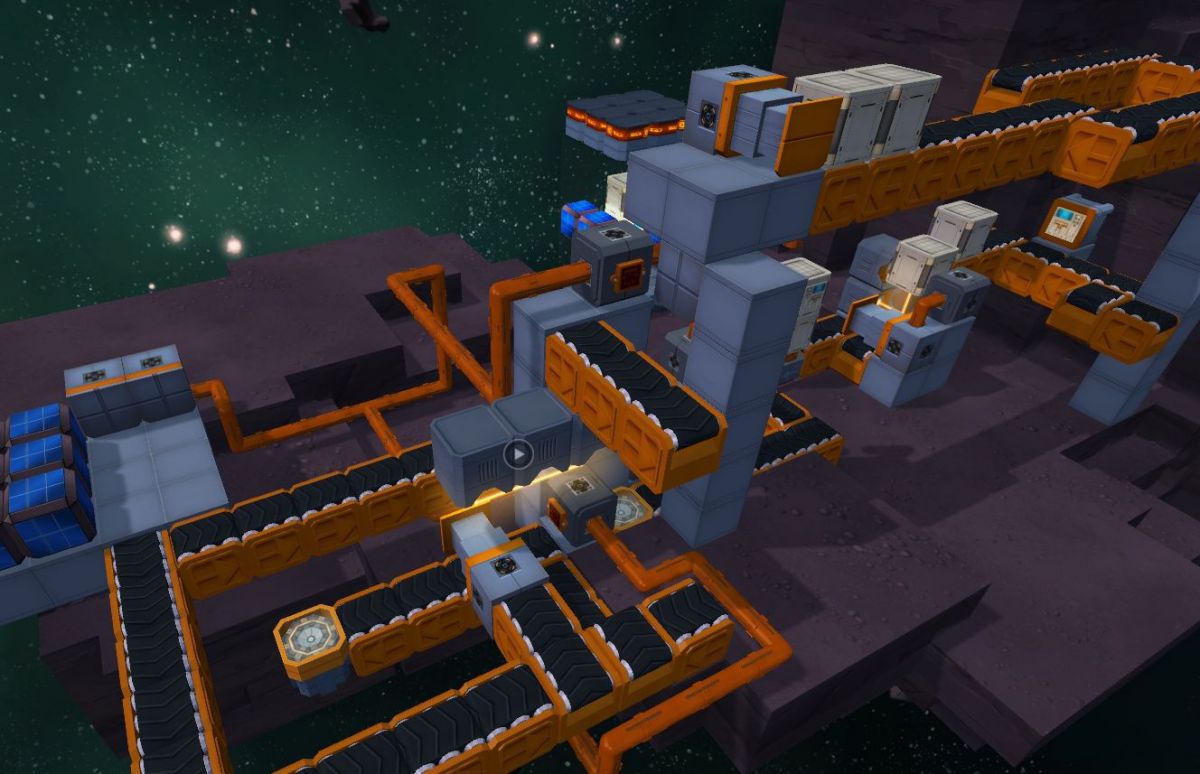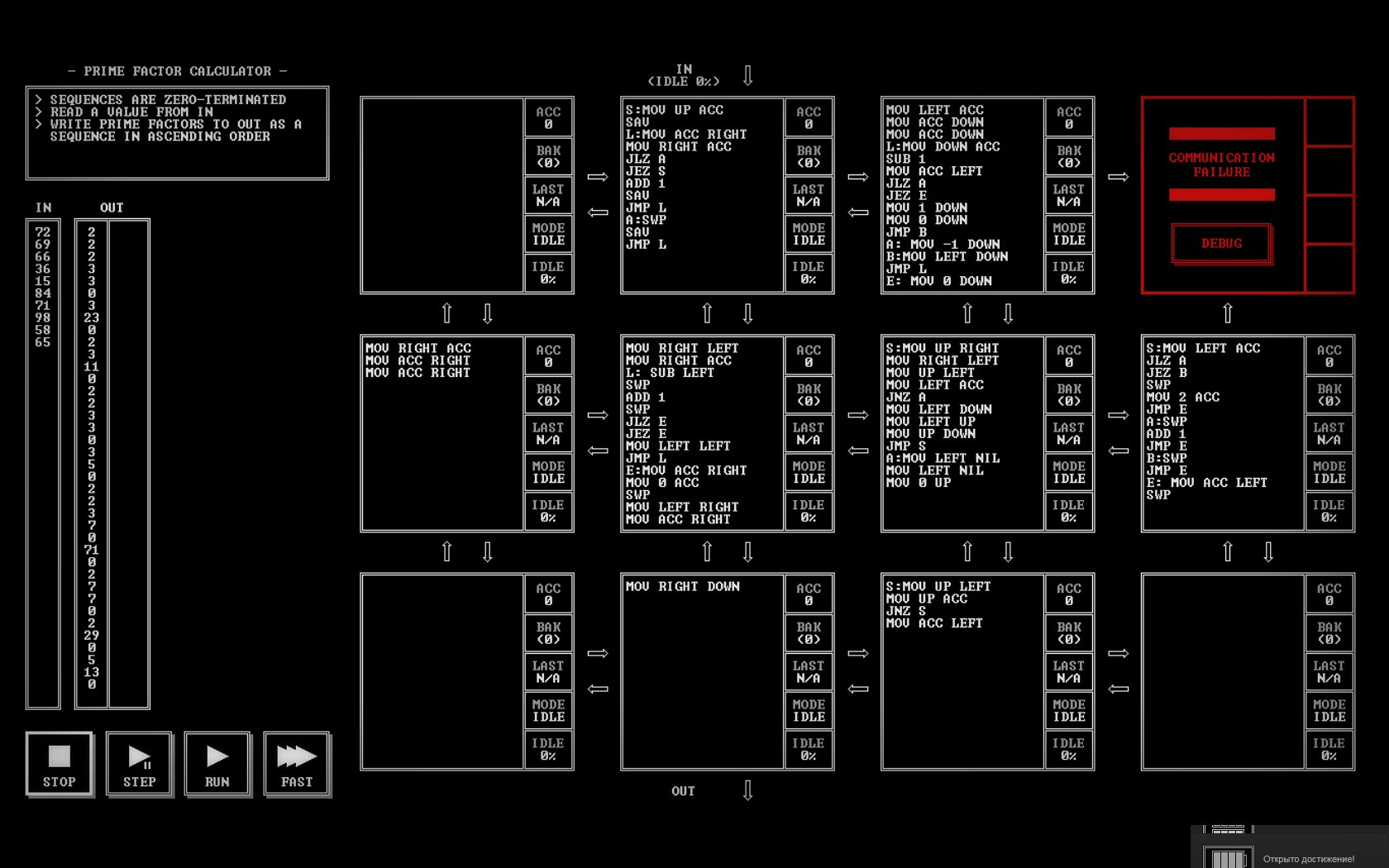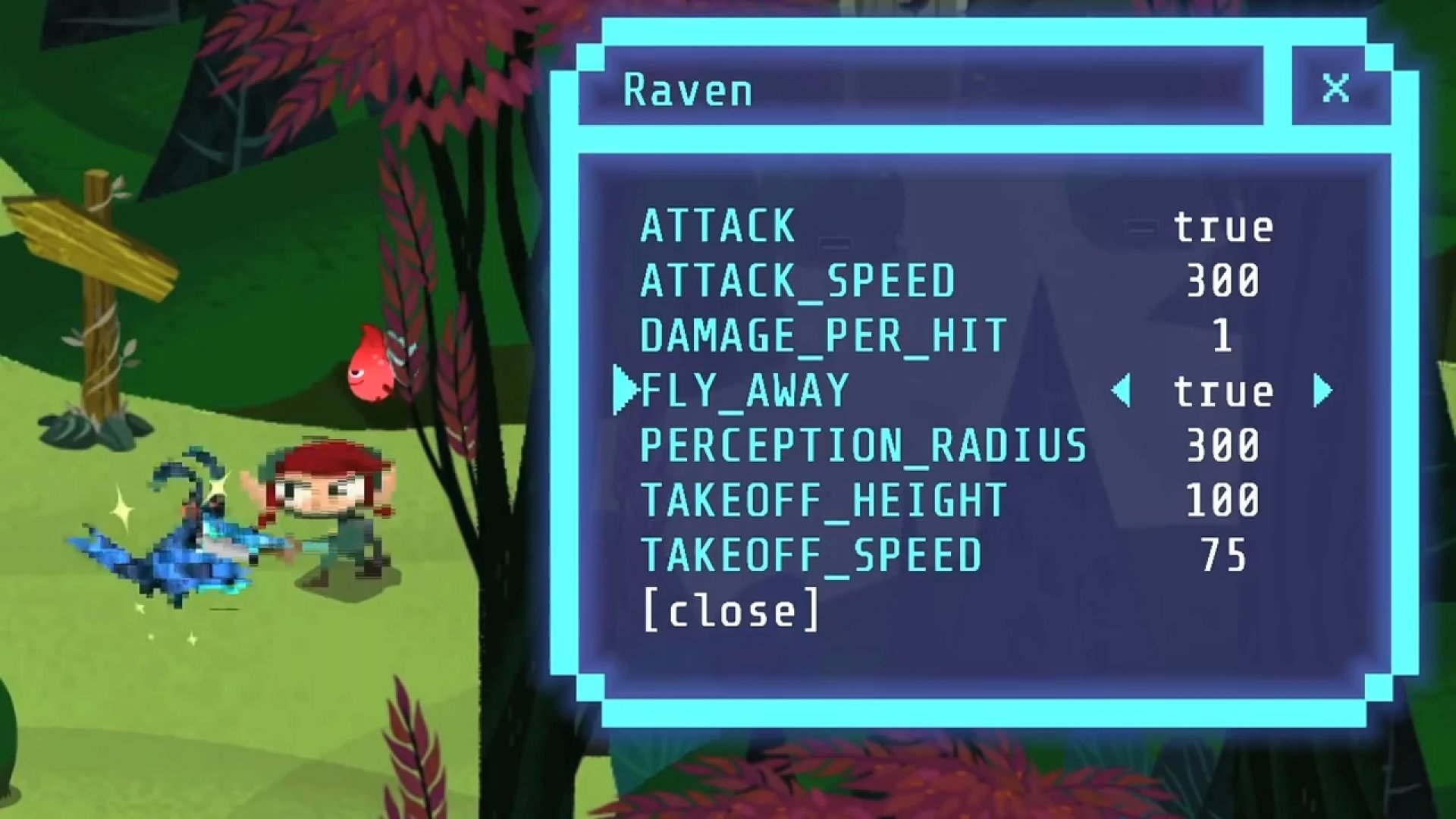Games for programmers, part two
It's been four and a half years since I, using a freshly received invite , wrote the previous post with a similar title. Great time for the gaming industry. Many new good games have appeared, and recently I felt an urgent need to share knowledge of them with the general public.
Despite the danger of a dispute over the name again , I decided to keep it the same in order to maintain continuity. You can perceive it as a “game for those who have the ability to program,” or something else like that. However, I believe that you are not reading this post for the sake of reasoning about semantics, so let's get to the point.

Another game from the author of the magnificent SpaceChem, with a review of which began my previous post. Now (fanfare and screaming schoolgirls) - in 3D! In principle, the presence of the third dimension is the most significant difference from the previous game. The essence of the gameplay has not undergone special changes: you need to take parts from the entrance, make other parts of them and send them to the exit. However, it cannot be said that Infinifactory is purely secondary. The presence of gravity, methods of manipulation with the details - all this creates a completely new task, without causing a feeling of deja vu.
')
Separate pleasure gives the plot. Yes, yes, the plot of the puzzle about the creation of pipelines. Almost production drama ... in space. The main character was kidnapped by powerful, but rather stupid aliens, and now he works for them for food. The plot has an impact on how exactly the sets of cubes on the inputs and outputs of the conveyor are called and look like. I think you will never be able to erase from memory the mission of making whale canned. You can still remember the wonderful cynicism with which the game forces you to build an assembly of single cameras, completely similar to the one in which you are between missions. But why am I writing this? You probably already quit reading and went to install the game.
By the way, an interesting fact: the similarity with Minecraft is not accidental. The creator of Infinifactory is also the author of the old little-known game Infiniminer, one of the ideological clones of which Minecraft once became.

The game of the same developer, about which there is already a separate article on Habré, but I will still write about it in my own words, because I like to write, but the game deserves it. In short, this is a simulator of a primitive multi-threaded assembler, on which you have to write a variety of hello worlds. Its capabilities are poor, and a very limited number of lines are placed in each node, which is why the programmer has difficulties, which (I hope) are unlikely to occur in real work. And so that life does not seem honey, the nodes communicate with each other asynchronously. From these difficulties, the essence of the game is born: not a single node can fully implement any complex algorithm, therefore it is necessary to divide it between the nodes, sometimes in a cruel and unnatural way.
Yes, and there is also a plot. The plot of the game about multi-threaded assembler. It sounds even funnier than the old Tetris: Story Mode joke. Its essence is that the main character is inherited a vintage-looking device with a very strange architecture. Programming it, the hero recovers data from broken nodes and gradually learns its history - where it came from, what it was created for. And I must say, this is not the knowledge, acquaintance with which passes without a trace ...

And here is another assembler. Deceptively simple, with cartoon graphics and “mouse programming”. Probably, not one child, having received as a gift a “children's developmental” game, in a rage, broke the keyboard on his knee, trying to optimize the solution of some kind of retardedly simple task so that it could be performed two measures faster.
In fact, if the child is not a perfectionist, aiming at one hundred percent passing, then this will really be a good learning game for him. And, and more, if anyone is interested, the creators of the Human Resource Machine are those who made World of Goo.
By the way, since we started talking about learning games ...

After such low-level things as an assembler, why not ... go down a level? MHRD is a game about logical elements in which a player, with his hands, one might say, collects a full-fledged processor from bare NAND. Moreover, the game brings him to this smoothly, without sharp jumps in complexity. In my opinion, the passage of this game should be given as a laboratory work to courses like "Computer Architecture".
The “plot” of the game is uncomplicated, like in the good old German cinema : the player is hired by MicroHard, which wants to conquer the processor market, or something like that. Accordingly, while it will conquer the market, the player must assemble the processor itself. This is done using a kind of "programming language", which describes the elements and their relationships. Once the assembled element can be reused in further diagrams, without describing it again each time.
Unfortunately, the game did not have quite a bit to become a true diamond. “IDE” slows down, there is no possibility to play interactively with the collected elements. The game is not great, but very good.

Sometimes players hack games to make their passing easier. But what about the game in which hacks are necessary for passing? Hack'n'Slash begins with the fact that the main character (whose similarity with the Link from Legend of Zelda is, of course, quite by accident) finds a strange sword ending in a USB-plug. Poking this sword into various game objects, it can change their properties — for example, the most banal, set the monster's health value to “0”.
Later, the hero finds new artifacts that do other useful things - for example, showing collision boxes of all objects on the screen. And to defeat the final boss you need to modify the scripts of the game itself, written, by the way, in the Lua language. To be honest, the graphics freeze me a little, but from the gameplay point of view, the game is very curious.
And since we are talking about graphics ...

Since we are talking about graphics, Hack'n'Slash has a twin brother who is nicer to me for three reasons. First, it is free and open source. Secondly, it is in ASCII graphics, which warms my heart as a person who has passed the original Dungeon Crawl. And thirdly, he has JS under the hood, not Lua - here, of course, a matter of habit, but the first one is already dearer to me for the Russian, and I dealt with the second only when writing small mods to Don't Starve.
Gameplay is similar to what happens at the very end of Hack'n'Slash: the player gets access to the game code itself and can modify its individual sections, which is necessary for passing. The game is witty and beautiful; Its only drawback is that it is too short.
Well, perhaps that's all. See you in the third part, after another four and a half years.
PS I foresee that the comments mention Shenzen IO. I am aware of its existence, but, unfortunately, I did not have time to play it yet, and therefore did not write about what I really do not know.
Despite the danger of a dispute over the name again , I decided to keep it the same in order to maintain continuity. You can perceive it as a “game for those who have the ability to program,” or something else like that. However, I believe that you are not reading this post for the sake of reasoning about semantics, so let's get to the point.
Infinifactory

Another game from the author of the magnificent SpaceChem, with a review of which began my previous post. Now (fanfare and screaming schoolgirls) - in 3D! In principle, the presence of the third dimension is the most significant difference from the previous game. The essence of the gameplay has not undergone special changes: you need to take parts from the entrance, make other parts of them and send them to the exit. However, it cannot be said that Infinifactory is purely secondary. The presence of gravity, methods of manipulation with the details - all this creates a completely new task, without causing a feeling of deja vu.
')
Separate pleasure gives the plot. Yes, yes, the plot of the puzzle about the creation of pipelines. Almost production drama ... in space. The main character was kidnapped by powerful, but rather stupid aliens, and now he works for them for food. The plot has an impact on how exactly the sets of cubes on the inputs and outputs of the conveyor are called and look like. I think you will never be able to erase from memory the mission of making whale canned. You can still remember the wonderful cynicism with which the game forces you to build an assembly of single cameras, completely similar to the one in which you are between missions. But why am I writing this? You probably already quit reading and went to install the game.
By the way, an interesting fact: the similarity with Minecraft is not accidental. The creator of Infinifactory is also the author of the old little-known game Infiniminer, one of the ideological clones of which Minecraft once became.
TIS-100

The game of the same developer, about which there is already a separate article on Habré, but I will still write about it in my own words, because I like to write, but the game deserves it. In short, this is a simulator of a primitive multi-threaded assembler, on which you have to write a variety of hello worlds. Its capabilities are poor, and a very limited number of lines are placed in each node, which is why the programmer has difficulties, which (I hope) are unlikely to occur in real work. And so that life does not seem honey, the nodes communicate with each other asynchronously. From these difficulties, the essence of the game is born: not a single node can fully implement any complex algorithm, therefore it is necessary to divide it between the nodes, sometimes in a cruel and unnatural way.
Yes, and there is also a plot. The plot of the game about multi-threaded assembler. It sounds even funnier than the old Tetris: Story Mode joke. Its essence is that the main character is inherited a vintage-looking device with a very strange architecture. Programming it, the hero recovers data from broken nodes and gradually learns its history - where it came from, what it was created for. And I must say, this is not the knowledge, acquaintance with which passes without a trace ...
Human resource machine

And here is another assembler. Deceptively simple, with cartoon graphics and “mouse programming”. Probably, not one child, having received as a gift a “children's developmental” game, in a rage, broke the keyboard on his knee, trying to optimize the solution of some kind of retardedly simple task so that it could be performed two measures faster.
In fact, if the child is not a perfectionist, aiming at one hundred percent passing, then this will really be a good learning game for him. And, and more, if anyone is interested, the creators of the Human Resource Machine are those who made World of Goo.
By the way, since we started talking about learning games ...
MHRD

After such low-level things as an assembler, why not ... go down a level? MHRD is a game about logical elements in which a player, with his hands, one might say, collects a full-fledged processor from bare NAND. Moreover, the game brings him to this smoothly, without sharp jumps in complexity. In my opinion, the passage of this game should be given as a laboratory work to courses like "Computer Architecture".
The “plot” of the game is uncomplicated, like in the good old German cinema : the player is hired by MicroHard, which wants to conquer the processor market, or something like that. Accordingly, while it will conquer the market, the player must assemble the processor itself. This is done using a kind of "programming language", which describes the elements and their relationships. Once the assembled element can be reused in further diagrams, without describing it again each time.
Unfortunately, the game did not have quite a bit to become a true diamond. “IDE” slows down, there is no possibility to play interactively with the collected elements. The game is not great, but very good.
Hack'n'Slash

Sometimes players hack games to make their passing easier. But what about the game in which hacks are necessary for passing? Hack'n'Slash begins with the fact that the main character (whose similarity with the Link from Legend of Zelda is, of course, quite by accident) finds a strange sword ending in a USB-plug. Poking this sword into various game objects, it can change their properties — for example, the most banal, set the monster's health value to “0”.
Later, the hero finds new artifacts that do other useful things - for example, showing collision boxes of all objects on the screen. And to defeat the final boss you need to modify the scripts of the game itself, written, by the way, in the Lua language. To be honest, the graphics freeze me a little, but from the gameplay point of view, the game is very curious.
And since we are talking about graphics ...
Untrusted —or— the Continuing Adventures of Dr. Eval

Since we are talking about graphics, Hack'n'Slash has a twin brother who is nicer to me for three reasons. First, it is free and open source. Secondly, it is in ASCII graphics, which warms my heart as a person who has passed the original Dungeon Crawl. And thirdly, he has JS under the hood, not Lua - here, of course, a matter of habit, but the first one is already dearer to me for the Russian, and I dealt with the second only when writing small mods to Don't Starve.
Gameplay is similar to what happens at the very end of Hack'n'Slash: the player gets access to the game code itself and can modify its individual sections, which is necessary for passing. The game is witty and beautiful; Its only drawback is that it is too short.
Well, perhaps that's all. See you in the third part, after another four and a half years.
PS I foresee that the comments mention Shenzen IO. I am aware of its existence, but, unfortunately, I did not have time to play it yet, and therefore did not write about what I really do not know.
Source: https://habr.com/ru/post/336364/
All Articles